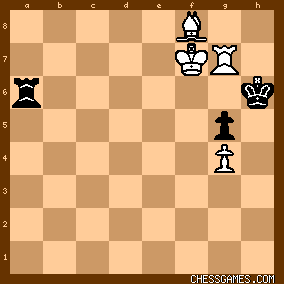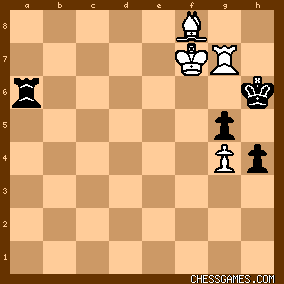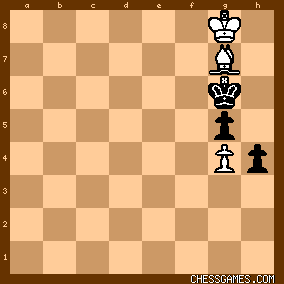|
< Earlier Kibitzing · PAGE 2 OF 2 ·
Later Kibitzing> |
| Nov-07-04 | | Dudley: I wonder why Fischer didn't move 40.Rg7 + Kh6 41.Rf7+? That would have forced the loss of an exchange. |
|
| Nov-07-04 | | Gregor Samsa Mendel: This seems like deja vu all over again. <Fresh> and <Dudley>--black's king can just go back to g6. |
|
| Nov-07-04 | | Dudley: Oh yeah. |
|
| Nov-07-04 | | aw1988: 39. Rg7+?? Kxg7 |
|
| Nov-08-04 | | Garland356: First K can't attack g7 cause of the Bishop. Next after Kh6 the bishop is alone. Where's the loss of an exchange? |
|
| Nov-09-04 | | Dudley: The idea was that 40.Rg7+ forces the king to h6. then Rf7 discovered check forces RxB(on f8), then RxR. However, the king just goes back to g6. 39.Rg7 was supposed to be 40.Rg7. Just a simple mass hallucination and certainly more than enough discussion! |
|
| Apr-15-07 | | Ulhumbrus: Instead of 6..d4. 6...Bg4 pins the Ne2 and on 7 Nxd5 Nd4 threatens ...Nf3+ removing White's right to castle. On 6...Bg4 7 Bxd5 Nd4 80-0 Nf3+ 9 Kh1 Nf6 is worth looking at further. |
|
| Aug-10-07 | | RookFile: Here we have Fischer playing the more traditional role of favorable bishop vs. knight, and he certainly still remembers what to do. |
|
| Aug-24-07 | | RookFile: Earlier in his career (the 1960's) - Fischer had spent a lot of time studying all the openings, in depth, even ones that he didn't play. Returning from retirement, Fischer was able to cash in on some of this work. He must have decided in his pre-match preparations that the Open Sicilian against Spassky was not something he wanted to play too often.
Spassky, on the other hand, would have had no way of knowing, before the match, that Fischer would play this way. This is an example of Fischer's wonderful versatility, and ability to adapt his game to schemes that are most uncomfortable against his opponent. |
|
| Aug-24-07 | | arnaud1959: For any player R+B is stronger than R+N.
For Fischer R+B wins against R+N. |
|
| Aug-24-07 | | Marmot PFL: RJF- "Maybe the opening was slightly better for me, or even. That was a very risky move, 20...Nb4, and that was where the trouble began for Boris." |
|
| Nov-27-08 | | adarknight: Who one this game?? Why does it end before a mate |
|
| Nov-27-08 | | Pyke: <adarknight: Who one this game?? Why does it end before a mate> Hello <Adarknight> Most games do NOT end with a mate. Mostly players will resign in a hopeless position (for example when material is lost) or when mate cannot be avoided. Make sure you read all of the Kibitzes, that means the posts, on a game - yeah, I know it takes time to do so, but it's time well spent and worth it. Most likely you will find an explanation on why the game was won or lost; and a sample continuation of moves showing it. And by the way, welcome to chessgames.com! Enjoy your stay ... |
|
| Nov-29-08 | | adarknight: Thanks pyke! |
|
| Mar-14-09 | | chesswonder: placing pawns on the same color as the bishop??
|
|
| Mar-12-11 | | fab4: Nice finish. Spassky thrashing around whilst being reeled in. |
|
| Mar-12-11 | | hottyboy90: Lovely game there are some real classic games to study in this match. I am only stuck on one question. Can Spassky not draw by perpetual or else Fischer gets a terrible position?? someone please answer this! =) |
|
| Mar-13-11 | | Keith Dow: Dear hottyboy90,
No perpetual check.
58 ... Ra7+
59 Kg8 |
|
| Mar-13-11 | | hottyboy90: 59...Rxg7+, 60Bxg7+ Kg6. Is that a draw? Keith Dow what would you give as the continuation now?? 61.Be5 perhaps stopping the monster passed pawn on the H-File? |
|
| Mar-13-11 | | hottyboy90: I see it now Keith white will eventually force zugzwang and take the g pawn... |
|
| Nov-17-11 | | AnalyzeThis: This game is a reminder of how little of an advantage Fischer needed to win. You look at the endgame as it is developing - yeah, white is a little better, nothing special. Then Fischer grinds it out and wins. |
|
| Nov-17-11 | | King Death: This type of play was second nature to Fischer. Many of the crushing attacks he got in other games were due to his opponents avoiding just this kind of clear advantage in simpler positions, because they were astute enough to realize they had no chance. |
|
| Dec-23-13 | | Owl: Classic RB vs RN endgame |
|
| Dec-23-13 | | Petrosianic: <Owl>: <Classic RB vs RN endgame> As long as we're stating the obvious, you might also mention that Fischer was White and Spassky was Black. |
|
Aug-21-16
 | | PawnSac: < adarknight: Who one this game?? Why does it end before a mate > Pyke certainly answered your question, but for the sake of the less experienced, or those relatively new to chess... Top level GM's spend thousands of hours studying end game positions, so when it comes to a game like this, they already know the outcome and when it is hopelessly lost.
The game final position is a classic textbook example (as are many of Bobby's games), and contain some very important features that every player should understand. It therefore merits a little bit of < Endgames 101 >. < hottyboy90: 59...Rxg7+, 60Bxg7+ Kg6. Is that a draw? > Unfortunately for black he has the h4 pawn, so it is not a draw.
WITHOUT THE H PAWN black could force a stalemate:

click for larger viewIn this position black simply plays ..Rf6+! If white captures the rook black is stalemated. If he instead plays Kg8 then RxB+! forces the stalemate! Every player should memorize this tactic as it can save you from a loss.
In fact, there are games in the CG database where the defender of a hopelessly
lost position will baracade himself into a hole then play this kind of idea
to gain the draw.
< THE ACTUAL GAME FINAL POSITION > 
click for larger viewIf black was to make a non-check rook move off the 6th rank (like ..Ra5 to guard his pawn), white can play Rg6+ Kh7 Rh6#.
But neither can he keep the rook on the 6th rank since Rg6+ is a double check forcing the black king to h7,
then white captures the rook followed by Rh6#. Thus black must check. ..Ra7+ is forced to prevent mate.
So after 58. ..Ra7+ 59.Kg8

click for larger view..it is clear black has no safe square for his rook. If ..Ra5 (or anywhere else on the A file)
then white plays Ra7+ discovered check with the B and wins the black R.
Thus the rook exchange is forced.
59. ..RxR+ 60.Bxg7+ Kg6 and now in this position...

click for larger view< hottyboy90: 61.Be5 perhaps stopping the monster passed pawn on the H-File? > Actually, anywhere else on the a1-h8 diagonal (like a1 b2 c3 or d4). The objective
is to force a black move while guarding the escape square f6. So after say 61.Bd4
black must either move the K or pawn. If he moves the pawn ..h3 THEN 62.Be5!
Black must then choose between ..Kh6 or give up the pawn.
If black gives up the pawn then on the next move he is forced to move the K.
If he goes to f6 white plays Kh7 and comes up to h5 or if black goes to h6
white plays Kf7 and comes up to f5. In either event black is forced to abandon
the guard of his pawn and white then promotes to a Q. So as you can see, at candidate master level play and above, this is an elementary win for white and there is no need to play it out (unless of course white is very low on time and black may try to win on the clock). |
|
 |
|
< Earlier Kibitzing · PAGE 2 OF 2 ·
Later Kibitzing> |





